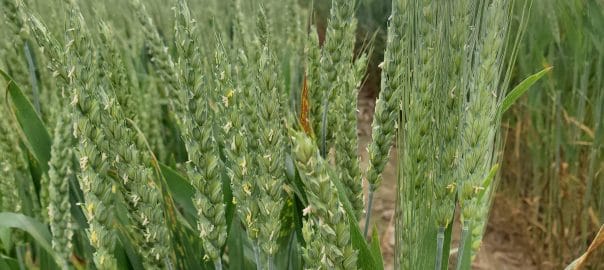Wheat is in bloom and when considering a fungicide application one needs to assess their risk for fusarium head blight (FHB) or head scab infection.
Factors that will influence a field’s risk for FHB/head scab infection include:
- Variety (susceptible or tolerant to scab)
- Previous crop (wheat planted after corn is at higher risk, since corn is also a host to the pathogen)
- Weather and timing (see details below)
FHB/Head Scab infection is favored by extended periods of moisture (3 or more days with frequent rainfall) or relative humidity (>90%) and moderately warm temperatures (between 59 to 86°F). These conditions present before, during, and after bloom favor spore production, flower infection, and colonization of developing grains. The Fusarium Head Blight Prediction Center (www.wheatscab.psu.edu) uses models to estimate Head Scab risk using weather variables observed seven days prior to flowering.

A note on the forecast website – it is best viewed with the following web browsers: Chrome, Firefox, and Safari (Internet Explorer has had some compatibility issues in the past). While evaluation of these models have shown them to be correct 75% of the time, it is still recommended to evaluate your local weather and wheat field as it approaches bloom to better guide fungicide application decisions.
While wheat is susceptible to infection from head emergence until harvest, infections initiated at and soon after anthesis have the greatest destructive potential. Research has shown the most effective timing for controlling FHB and mycotoxin levels is at initial bloom/flowering (Feekes 10.5.1), which relates to at least 50% of the heads blooming in a field. Although applications made 5 to 6 days after initial bloom can also provide a benefit in reducing FHB and mycotoxin levels. Applications made at earlier growth stages, such as flag leaf, do not provide control of FHB and mycotoxin levels.
Only fungicide products that DO NOT contain a Strobilurin/QoI (i.e. DO NOT have FRAC or fungicide group 11 on the label) should be applied for prevention/management of Head Scab because products that do contain a strobilurin/QoI can increase the mycotoxin levels in FHB infected wheat. The best products currently available for reducing scab symptoms and mycotoxin levels are Caramba, Prosaro, and Miravis Ace (new to the market). Although these fungicides, like all fungicides, are not going to provide 100% control, research trials have shown that FHB symptoms and mycotoxin levels can be reduced by approximately 40-60% relative to a non-treated check. Multiple factors contribute to this level of control which include fungicide efficacy, application coverage, timing in respect to wheat growth stage (all the heads in a field will not be flowering at the same time), and disease risk (i.e. weather before, during, and after application). A more comprehension fungicide table can be found at UTcrops.com (Wheat fungicide Table).
The bottom line is that fungicides can reduce scab/FHB disease and mycotoxin levels, but pairing fungicide with a resistant variety will provide the best protection and both the FHB forecast model, along with your local forecast and information about your own field will better guide fungicide application decisions.


